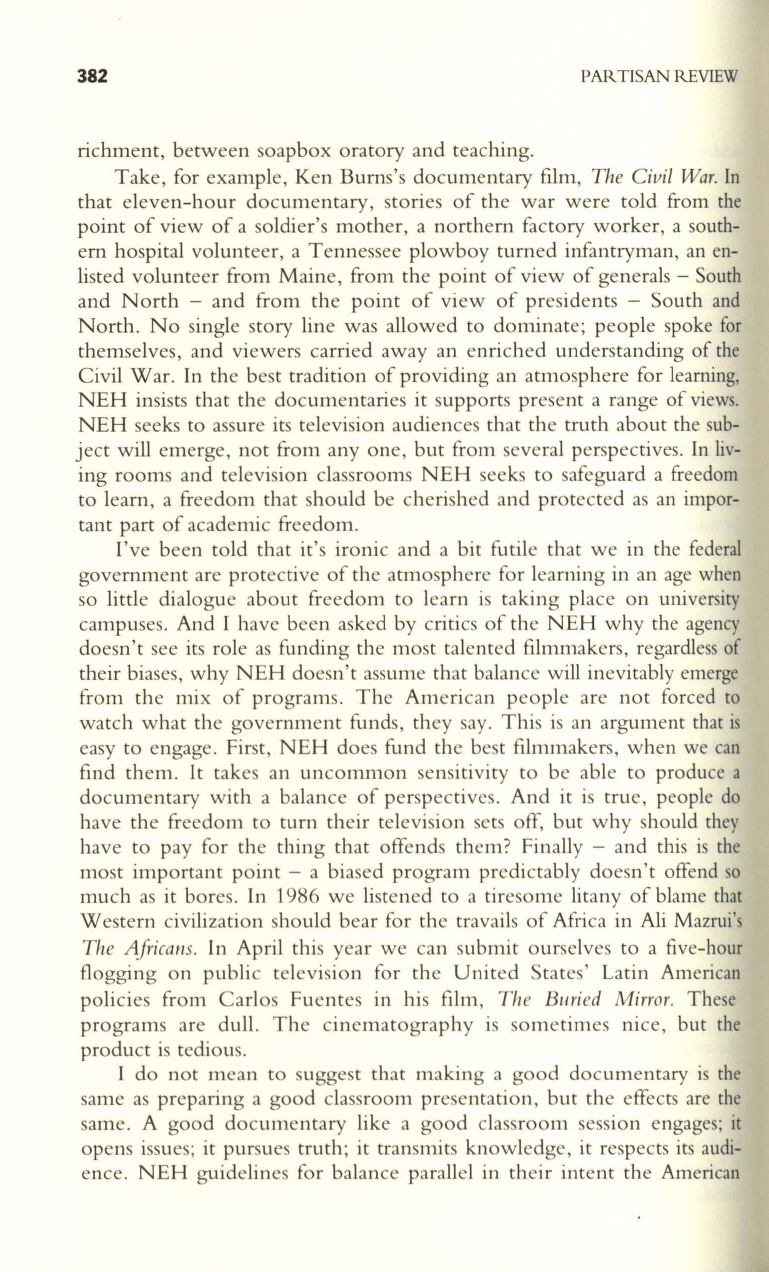
382
PAR.TISAN REVIEW
richment, between soapbox oratory and teaching.
Take, for example, Ken Burns's documentary film,
The
Civif
War.
In
that eleven-hour documentary, stories of the war were told from the
point of view of a soldier's mother, a northern factory worker, a south–
ern hospital volunteer, a Tennessee plowboy turned infantryman, an en–
listed volunteer from Maine, from the point of view of generals - South
and North - and from the point of view of presidents - South and
North. No single story line was allowed to dominate; people spoke for
themselves, and viewers carried away an enriched understanding of the
Civil War. In the best tradition of providing an atmosphere for learning,
NEH insists that the documentaries it supports present a range of views.
NEH seeks to assure its television audiences that the truth about the sub–
ject will emerge, not from anyone, but from several perspectives. In liv–
ing rooms and television classrooms NEH seeks to safeguard a freedom
to learn, a freedom that should be cherished and protected as an impor–
tant part of academic freedom.
I've been told that it's ironic and a bit futile that we in the federal
government are protective of the atmosphere for learning in an age when
so little dialogue about freedom to learn is taking place on university
campuses. And I have been asked by critics of the NEH why the agency
doesn't see its role as funding the most talented filmmakers, regardless of
their biases, why NEH doesn't assume that balance will inevitably emerge
from the mix of programs. The American people are not forced to
watch what the government funds, they say. This is an argument that is
easy to engage. First, NEH does fund the best filmmakers, when we can
find them. It takes an uncommon sensitivity to be able to produce a
documentary with a balance of perspectives. And it is true, people do
have the freedom
to
turn their television sets off, but why should they
have to pay for the thing that offends them? Finally - and this is the
most important point - a biased program predictably doesn't offend so
much as it bores. In 1986 we listened to a tiresome litany of blame that
Western civilization should bear for the travails of Africa in Ali Mazrui's
The Africans.
In April this year we can submit ourselves to a five-hour
flogging on public television for the United States' Latin American
policies from Carlos Fuentes in his film,
The Bltried Mirror.
These
programs are dull. The cinematography is sometimes nice, but the
product is tedious.
I do not mean to suggest that making a good documentary is the
same as preparing a good classroom presentation, but the effects are the
same. A good documentary like a good classroom session engages; it
opens issues; it pursues truth; it transmits knowledge, it respects its audi–
ence. NEH guidelines for balance parallel in their intent the American


